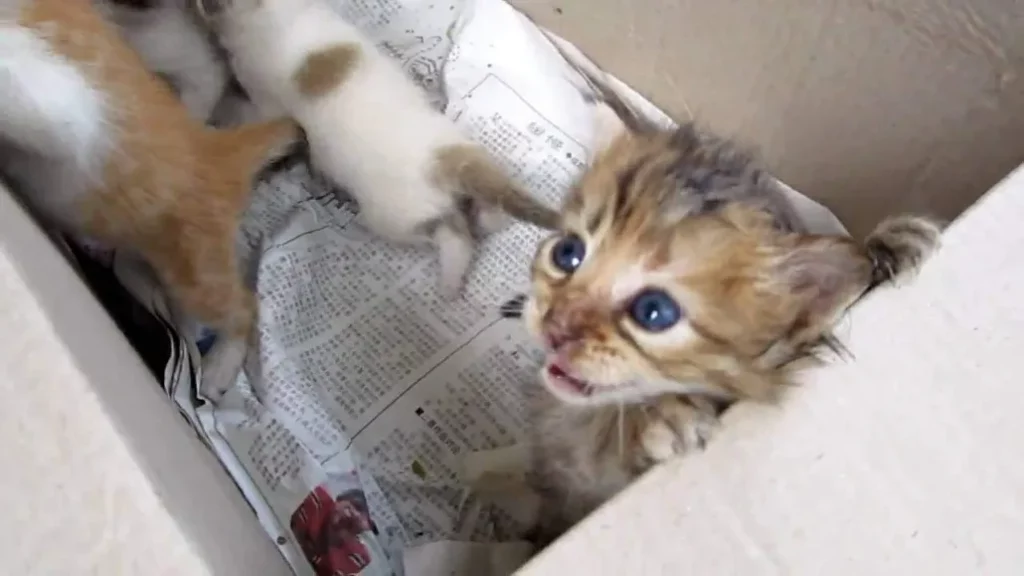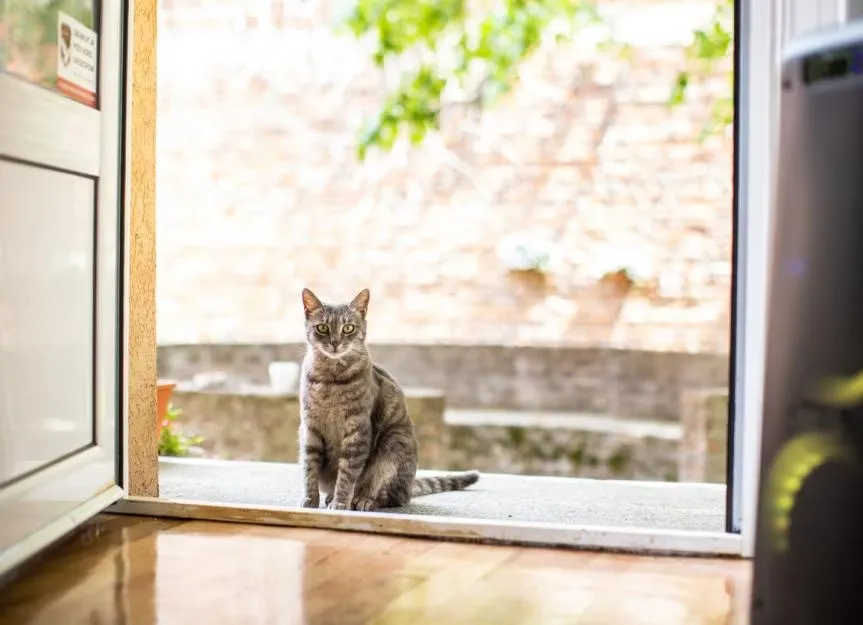Do you want to know what to do with a stray kittens? Here, you will get to know what you can do with stray kittens when you come across one.

Stray kittens often find themselves without a home or proper care, leaving concerned individuals unsure of how to help these vulnerable animals.
Understanding the best approach when encountering stray kittens is crucial to ensure their well-being.
Here, we’ll cover various steps and tips on what to do when you come across stray kittens in different situations.
What to Do With Stray Kittens?

Here are what to do when you find stray kittens in front of you:
1. Identify the Stray Kittens
Recognizing stray kittens is the first step in helping them.
They are often alone or seen wandering without a mother.
Newborn kittens generally have closed eyes and folded ears, while older ones might have visible signs of distress or weakness.
Also, understanding their age and health is vital for appropriate care.
2. Approach the Kittens With Caution
When encountering stray kittens, it’s essential to approach them cautiously.
When you approach these kittens, they might be scared or in need of immediate assistance.
Gently assess their condition from a safe distance to avoid startling them.
In some cases, the mother might be nearby, so observation before intervention is advisable.
3. Contact Animal Welfare Organizations
One of the best steps to take is to contact local animal welfare organizations or shelters.
Also, these organizations often have the resources, experience, and facilities to handle stray kittens appropriately.
They can provide guidance, and medical care, and even facilitate adoptions if necessary.
4. Provide Temporary Shelter and Care
If immediate assistance from an animal welfare organization isn’t available, there are temporary measures to ensure the stray kittens’ safety and well-being.
Also, creating a warm, safe, and quiet space for them is crucial.
In addition, you can use a cardboard box or a carrier lined with soft blankets and provide fresh water and kitten food, ensuring it’s appropriate for their age.
5. Health Assessment and Veterinarian Visits
Stray kittens might need medical attention due to malnutrition, infections, or injuries. Upon rescuing them, a visit to a veterinarian is highly recommended.
Also, the vet can assess their health, provide necessary vaccinations, and address any medical issues they might have.
6. Try to Socialize them With Hunab Before the Adoption
Should you decide to care for the stray kittens, it’s essential to socialize them to human interaction and, if possible, with other animals.
Socialization can significantly increase their chances of being adopted into loving homes.
Additionally, contacting local adoption centers can help find suitable forever homes for these kittens.
7. TNR (Trap-Neuter-Return) Programs
In cases where stray kittens are part of a larger community of feral cats, TNR programs can be incredibly helpful.
Also, these programs involve trapping, neutering, and returning these cats to their original location.
TNR helps control the population and ensures that the cats are not contributing to more stray kittens in the future.
What to Do With Stray Kittens Outside?

If you come across stray kittens outside, there are several steps you can take to ensure their safety and well-being:
1. Determine if The Stray Kittens is In Danger or Distress
Determine if the kittens are in immediate danger or distress. Also, check for signs of injury or sickness from the kittens.
If they seem healthy and safe, observe from a distance for a while to see if the mother cat returns.
Also, if the kittens appear to be in danger or are obviously sick or injured, take immediate action.
2. Contact Local Animal Shelters or Rescues
Reach out to local animal shelters or rescue organizations when you find a stray kitten outside.
They might be able to provide guidance, resources, or assistance in rescuing the kittens.
They may also have foster programs or volunteers who can take care of the kittens.
3. Provide Temporary Shelter
If the kittens are in a safe area and you can’t immediately get help, you might create a makeshift shelter using a cardboard box, lined with a warm blanket or towel.
Place the kittens inside and cover the box to keep them warm.
4. Provide Food and Water
If it’s safe to approach, offer some kitten-specific food (canned food or specialized kitten milk) and freshwater.
Do not give cow’s milk as it can cause digestive issues in kittens.
5. Handle the Kittens with Care
If you need to handle the kittens, do it gently and carefully.
Also, you can use gloves if possible, but ensure your hands are clean to avoid transmitting any potential diseases or parasites to the kittens.
6. Wait for the Mother Cat
If the kittens seem healthy and safe, the best option might be to wait for the mother cat to return.
She could be out looking for food or might be cautious of approaching when humans are nearby.
7. Look Out for Potential Foster Care
Consider fostering the kittens if you’re equipped to do so.
It involves providing proper care, feeding, warmth, and socialization until they’re old enough to be adopted.
8. Give it Veterinary Care
Once you’ve taken the kittens under your care, take them to a veterinarian for a health check. Vaccinations, deworming, and other necessary treatments might be required.
Remember, it’s crucial to approach stray kittens with caution, as they might be scared and potentially carry diseases.
If you’re unsure or uncomfortable handling them, contact local animal services or a rescue group for guidance or assistance.
The aim is to ensure the kittens’ safety and, if possible, reunite them with their mother or find them a proper home.
Where to Drop Off Kittens for Free?

There are several options to consider when looking to drop off kittens for free:
1. Animal Shelters
Local animal shelters often accept surrendered animals, including kittens. They have the ability to provide care and work to find suitable homes.
However, note that many shelters may have specific intake hours or procedures, so it’s a good idea to contact them in advance.
2. Rescue Organizations
Non-profit rescue groups sometimes have facilities or foster networks to take in kittens.
You can contact these organizations in your area to see if they have space available or can help find a foster home.
3. Veterinary Clinics
Some veterinary clinics collaborate with rescue groups or have the means to take in kittens.
They can accept surrendered animals or guide you to the appropriate resources.
4. Adoption Events or Pet Stores
Some pet stores collaborate with rescue groups or host adoption events.
Contact these places to inquire if they have space available for the kittens or if they can direct you to appropriate resources.
5. Online Platforms
There might be online platforms or forums where people offer or seek homes for pets.
Also, these can be local community groups, social media platforms, or dedicated websites for pet adoptions.
6. Friends and Family
Reach out to your network to see if someone is willing to adopt or foster the kittens.
Also, it’s important to ensure they’re going to a responsible and caring home.
When surrendering kittens, it’s essential to provide accurate information about their health, behavior, and any background details you might know.
Be honest about their condition and disclose any health issues. Also, this helps the new caretakers or shelters to provide appropriate care.
How to Take Care of a Stray Kitten Without a Mother

Taking care of a stray kitten without a mother can be a challenging but rewarding task. Here are steps to help care for the kitten:
1. Provide Warmth and Shelter for The Kitten
Ensure you provide a warm, safe environment for the kitten.
Also, use a small, cozy, and clean box or bed lined with soft blankets. In addition, ensure it’s in a draft-free area.
2. Feed Them With Small Bottles or Syringes
If the kitten is very young (less than four weeks old), it might need special care. A kitten milk replacer (never cow’s milk) is the best option.
Also, you can feed them with a small bottle or syringe every 2-3 hours. As the kitten grows, you can introduce wet kitten food, gradually transitioning to solid food.
3. Maintain Proper and Good Hygiene
Like a mother cat, you’ll need to help the kitten urinate and defecate. Also, gently rub the kitten’s genital area with a warm, damp cotton ball after feeding to stimulate elimination.
4. Provide Veterinary Care to the Kittens
Take the kitten to a vet for a health check. The vet can guide you on vaccinations, deworming, flea treatment, and other necessary care.
5. Socialize and Spend Time With the Kittens
Spend time with the kitten to provide social interaction and companionship. Also, this helps the kittens in their emotional development.
6. Encourage Play and Exercise
As the kitten grows, introduce toys and encourage play to help with their development and exercise.
7. Find a Permanent Home for the Kittens
As the kitten becomes ready for adoption, look for a loving and responsible forever home. You can contact local shelters, and rescue organizations, or use social networks to find suitable adopters.
In conclusion, caring for a stray kitten without a mother requires dedication and patience.
It’s important to do your best to mimic what a mother cat would do and ensure the kitten gets proper nutrition, warmth, and healthcare.
If you’re unsure or face challenges, seek guidance from a veterinarian or animal care professional.
Related Searches:

Leave a Reply